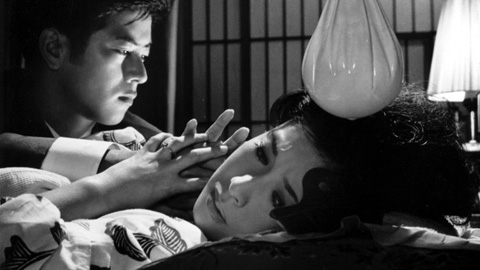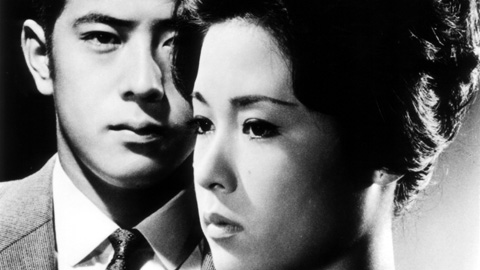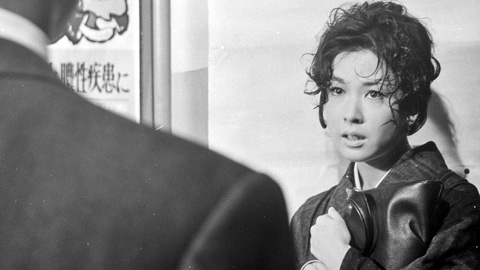A Wife Confesses
- Year
- 1961
- Original title
- Tsuma wa Kokuhaku Suru
- Japanese title
- 妻は告白する
- Director
- Cast
- Running time
- 91 minutes
- Published
- 20 May 2013



by Joan-Pol Argenter
The Daiei logo fades out, and a direct cut shows us a close-up of a middle-aged man chewing gum and looking to one side, to a background of urban racket. One automatically wonders: who is he, what is he doing, what does he want? After a few seconds the presumed main character raises a handheld camera and starts to compulsively turn its crank as his lens follows an arriving car. This vehicle is revealed by a first camera movement that, at the same time, opens up the shot so that we realize we are in front of the District Attorney’s office. The cameraman was waiting among many others to obtain visual carnage of the morbid trial of the moment. He will not appear again in the film. Or, to be more precise, we – the viewer – have become him: with a simple camera move, director Yasuzo Masumura makes us assume the role of the hungry voyeur who wants to know everything about the beautiful Ayako – note that the name of the character is the same as that of the actress who plays her – a woman accused of intentionally killing her husband on a mountaineering expedition in order to benefit from his expensive life insurance and to be with her young and attractive supposed lover, Osamu (an impeccable Hiroshi Kawaguchi, seen in the lead in Masumura’s debut Kisses and in Giants and Toys). This young man, incidentally, happens to be the one who convinced the husband of taking out said life insurance.
Did Ayako cut the rope to get rid of her husband or because this was actually her only way of surviving the situation? Is this young man who was with them at the time really her lover? With this apparently simple plot premise – maybe indebted to renowned classics like Billy Wilder’s film-noir gem Double Indemnity or Otto Preminger’s anthological trial drama Anatomy of a Murder, Yasuzo Masumura masterfully moves through the ambiguity of human behavior, along the thin line that separates rational justification from subconscious motivation. He delivers a kind of Antonionian inquiry on how the mean and the egotistical are without exception in the nature of modern man, or just plainly the human being. In fact, the Italian director comes to mind as a possible contemporaneous reference for A Wife Confesses, although the classical Hollywood of the time also joined the wagon of this type of psychological dramas, with for instance William Wyler’s The Children’s Hour, released the same year as Masumura’s film.
Just as the unfair and false accusations of having had a sexual relationship with her female co-worker is what provokes the blooming of the true homosexual passion in Shirley MacLaine’s character in Wyler’s film, the false accusation of adultery becomes self-fulfilling in Masumura’s. And again in the same way, the conscious justifications of self-defense presented by the character brightly incarnated by Ayako Wakao hide her true subconscious motivations: if the relationship with her husband had not been so abusive and disappointing, if his death hadn’t meant a free road to initiate a relationship much more pleasant and promising, she wouldn’t have decided so resolutely and quickly to cut the rope and send him to certain death. This is why the film is constructed around the fascinating paradox of having characters that, after defending in an upright way their innocence of the charges against them, with the viewer’s empathy and comprehension on their side, finally recognize and bow before the urges which they had tried so hard and so long to honestly refute.
Masumura’s film has been said to follow the pessimistic trail initiated by his Italian mentor Antonioni with such films as Cronaca di un amore, Le Amiche and Il Grido. It exhales a hostile and oppressive atmosphere from beginning to end. All the cinematographic tools used by the Japanese master are focused on this goal: first, the camera, with the right and reiterative use of tense angles and a depth of field that constantly draws the disquieting ins and outs from the relationships between the characters. Man and woman are forever enclosed in charged compositions that trap them or put them under the scrutiny of judges, lawyers, journalists, workmates, etc. Then there is the agile and surprising editing, full of ellipses and accelerated jumps between flashbacks and present day, precipitating the plot as if we were watching something like a Raoul Walsh action film mixed with the ruptures of the Nouvelle Vague. The photography, of an intense and baroque black, almost eats away the characters and is a work of art by cinematographer Satsuo Kobayashi, regular collaborator of Masumura’s. And finally the music by Riichiro Manabe, also the composer of Nagisa Oshima’s first features, who fills the film with strident and broken string pieces which persist even in those moments when the lead couple seems to find a temporary haven from their suffering. In doing so he makes the music ceaselessly deny any prospect of rest and enjoyment for the couple, creating a feeling of unease in the viewer.
The brilliance of Masumura also lies in creating rupture between the couple and conducting our empathy to the male side of the story. Film-noir genre conventions make us intuitively detect a femme fatale under the candidness of the female character, but this is the new wave and conventions no longer represent a guarantee, so taking his maneuver to its extreme, the filmmaker reveals Ayako’s character not as a perverse being but, borrowing the German philosopher’s words, human, too much human. An Ayako for whom no commodity offered by money has any sense without her beloved falls into desperation and crawls after Osamu to get him back. And this is where the true tragedy starts...
Amidst Yasuzo Masumura’s admirable filmography, A Wife Confesses seems to have been relegated to a dark corner, waiting to be claimed as one of his most notable features. Although it doesn’t enjoy the popularity of his more reputed works of the 1960s, and in comparison might look more conventional, it must be vindicated as one of his more passionate and stylized films, maybe the best one among his early features. It is, in conclusion, an example of both his mastery of noir classicism and his vigorous innovation of form and themes.